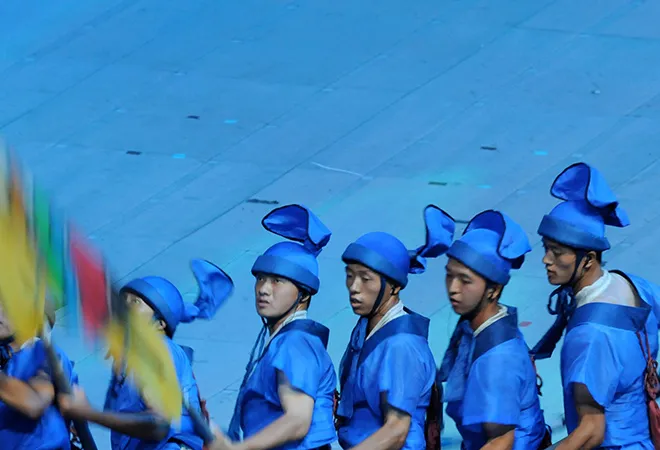 This is the twentieth part in the series
This is the twentieth part in the series The China Chronicles.
Read all the articles here.
Over a month has passed since India walked a lonely path and boycotted the Belt and Road Forum, China's showpiece international conference on its most ambitious economic and political initiative in recent times. The decision made news and provoked strong and divergent opinions, not least within India.
Prime Minister Narendra Modi's critics saw it as a mistake and a needless rejection of a Chinese investment and connectivity project that India could benefit from being a part of the initiative. The mainstream view, however, was that the Indian government had been left with no real option. As Prime Minister Narendra Modi's foreign policy team considered it, the Indian leader had made strenuous efforts to offer market access to the Chinese and gone out of his way to make them comfortable. President Xi Jinping had interpreted these gestures otherwise and snubbed India on a variety of issues, from opening up the Chinese market to Indian pharmaceutical products to Indian concerns on terrorism.
The Belt and Road Initiative was the final straw. One part of it, the China-Pakistan Economic Corridor, challenged Indian sovereignty as it passed through territory that India legally claimed. More than that individual BRI projects in South Asia and the Indian Ocean region, India's near neighbourhood, were pushing unviable investments, neo-colonial dependencies and potential political turmoil in a part of the world that had an impact on India. They were also regarded a political check on India's own and legitimate aspirations.
All of this background is well known. What is the state of play now? Three points are worth considering.
First, the Chinese were genuinely surprised, by the total and absolute absence of the Indian government at the BRI Forum. They said as much in informal conversations with Indian officials at later events, including at the Shanghai Cooperation Organisation (SCO) Summit in Astana. In a sense, they were misled — or allowed themselves to be, by commentary, analysis and feedback from sections of the strategic community in New Delhi.
Some in this community are old interlocutors of the Chinese, some, notably, are part of the current establishment. Not everybody believed that in the end Modi would cave and refuse to send anyone to the BRI Forum. Indeed, the degree to which the Indian prime minister sees the BRI as a strategic challenge to India and to his own legacy has been underestimated.
What Modi can do about this and whether he can promote Indian connectivity and infrastructure projects and maritime capacities to sufficient levels to provide workable alternatives — even if not absolute equivalents, for that is both difficult and unnecessary — to BRI is another matter. The fact is the Chinese misread his and his government's mood. That alone would require a Chinese reset, at least in tactical terms, and Beijing will need diplomatic antennae in the Indian capital to be upgraded in some form.
Second, India has clearly interpreted BRI as unacceptable Chinese expansionism. More than as a 'Marshall Plan for Asia' — at least as one wide-eyed Indian commentator described it — BRI is being looked upon as a series of bilateral projects between China and individual countries that are being packaged to resemble a multilateral framework.
"This is not multilateralism," explained one Indian official, "the New Development Bank is multilateral. Even the Asian Infrastructure Investment Bank (AIIB) is a multilateral institution, as there are internationally recognised norms governing it as well as multi-country ownership. BRI is not multilateral. It is Chinese owned and Chinese governed. Participation and co-financing by others and by genuine multilateral institutions is being thwarted by Beijing."
Third, the rise of BRI is directly proportional to American strategic confusion in Asia and the unstable nature of the early Donald Trump administration. As such, which allies can India turn to for support? In Europe, there is discomfort with Chinese attempts to divide and rule the European Union. In conversations with the Indian leadership, both the Germans and the French have indicated wariness with a potential Chinese shaped and led world order.
Yet, they are — at least the Germans are alive to gains from short-term commercial contracts that may arise as part of the BRI. As such, for the moment they are leaving India to do the talking publicly. Nevertheless, Indian benefit from a united European Union, with the integrity of the European project underwritten by Paris and Berlin, is stronger than at previous stages. Similarly, in the east, India's belief that the unity of ASEAN, such as it is, must be sustained, for as long as feasible, despite Chinese attempts to carve up the Southeast Asian grouping, is more pronounced today.
Whatever their long-term prospects, both ASEAN and the EU are seen as bulwarks to China in their current form. Indian investment, political and otherwise, and engagement with both specific countries in these associations as well the entities, as a whole will likely intensify. In that sense, unlike the early 2000s, India is now rediscovering "Old Europe" and its original "Look East" friends. These regions were once the route to America. Today, they are simply the alternative route.
The views expressed above belong to the author(s). ORF research and analyses now available on Telegram! Click here to access our curated content — blogs, longforms and interviews.



 This is the twentieth part in the series The China Chronicles.
Read all the articles
This is the twentieth part in the series The China Chronicles.
Read all the articles  PREV
PREV


